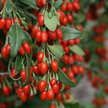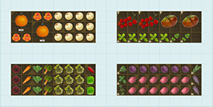You must first log in or sign up before accessing this page.
Legend
- Start Indoors
- Transplant
- Start Outdoors
- Care
- Harvest
- Succession Plant
Blackberry : Goji Berry Sweet Lifeberry (Lycium Barbarum)

Easy-to-grow flowering shrub with red berries
Goji is a sprawling shrub with long, flexible canes and clusters of small, grey-green leaves. The flowers are a brilliant royal purple and they appear in late spring/early summer along the length of the canes. They give way to juicy, bright red fruits that resemble small peppers. They grow sweeter as they mature on the plant. Goji plants continue to flower and produce fruit through the first heavy frost.
Zone: hardy to USDA zone 5; heat tolerant to AHS zone 9
Exposure: Full sun is best, but tolerates a bit of shade.
Height: 5-7’ (1.5-2.1 m)
Water: The plants tolerate some drought once established, but for best fruit set and quality, water regularly.
Soil: Any well-drained soil will do.
Staking: Goji naturally wants to sprawl and creep along the ground. To save space and to make harvesting the berries easier, you can bundle the strongest 3-5 canes around a 6-8’/1.8-2.4m tall stake (choose something sturdy, like 1”x1” wood).
Pests: Goji berry plants will not be bothered by insects or diseases, but birds, deer, and raccoons may all find the fruit as appealing as you do. If you notice damage to the fruit or plant, or have a problem with these visitors damaging other plants in your garden, use a netting or repellent, particularly once the plant begins flowering and fruiting.
Pruning: Goji does not require pruning to grow well and produce fruit. However, you may find the plant is more manageable and easier to harvest when its lateral (horizontal) branches are lightly pruned to encourage branching and the production of vigorous new growth.
Harvesting: Goji berries begin to ripen in early summer. They should be plucked off by hand when they are brilliant red and taste sweet. They come off the plant easily, without the need for pruners or a knife.
Fertilizing: For an abundant crop, apply a fertilizer formulated for flowering woody plants in early spring, just as new growth begins. Rose fertilizer is an excellent, readily available choice.
Rosaceae Rubus fruticosus
This is an example of the timeline you would see based on your growing conditions.
Blackberry: Blackberries
Goji Berry Sweet Lifeberry (Lycium Barbarum)
Blackberries are not true berries. Instead, it is botanically termed an aggregate fruit, meaning it is composed of small druplets. The plants have biennial canes and perennial roots, meaning the canes only bear fruit on two year old growth. Unmanaged mature plants form a tangle of dense arching stems, called a bramble. It is highly recommended that gardeners wishing to grow blackberries use a trellis system to keep their blackberry plants in control.
Basics
- Ease of Growing
- Easy
- Grown as
- Perennial
- Growing Habit
- Vine
- Hardiness
- Hardy
Plants are pretty hardy and can grow as far north as Alaska. Since they flower late, their flowers aren't damaged by late frost, either.
- Crops
- Spring Transplant, Fall Transplant
- Growing Season
- Short, Long
- Cultivar Type
- Mid-Season
- Growing Conditions
- Cold, Cool, Warm, Hot
They grow in every state in the United States so they're fairly adaptable. Cane berries are versatile and hardy in the coldest climates where other fruits fail.
- Outdoor Growing Temp
- 45°F - 85°F
- Min Outdoor Soil Temp
- 35°F
In mild climates Blackberry plants can be planted any time they are dormant from late autumn to early spring. In colder climates they are usually planted in spring. Of course the soil should not be frozen, so the temperature should be above 32˚ F.
- Start Indoors
- No
- Start Outdoors
- No
- Light
- Water
- Moderate
Blackberries are naturally quite drought tolerant (I have been amazed at their ability to survive months without water), but won't produce much fruit if they aren't given plenty of water during their budding and growth period. Lack of moisture when fruiting will result in smaller fruit that may not ripen properly. Water is also important after fruiting for the production of replacement shoots. Give the plants at least 1” of water per week or more if necessary.
- Feeder
- Heavy
Blackberries are very productive plants and do best in fertile soil. They can occupy the same soil for 15 years, so the ground should be amended heavily before planting.
- Suitability
- Drought tolerant, Tolerates light frost, Tolerates hard frost, Partial shade, Needs lots of space
- Small Gardens?
- No
- Containers?
- No
- Attracts beneficial insects?
- Yes
- Color
- Black
- Fruit Size
- 0.5 - 1.5"
- Plant Height
- 96.0 - 120.0"
- Plant Diameter
- - "
- Good Companions
- -
- Bad Companions
- -
- Hardiness Zone
- 5-11
- Disease Resistance
- -
- Taste Profile
Honey flavor.
- Rotation Group
- Perennial
Last Frost Date (LFD) refers to the approximate date of the last killing frost of spring.
Example first frost date on April 08.
First Frost Date (FFD) refers to the approximate date of the first killing frost of winter.
Example first frost date on November 01.
Current week.

